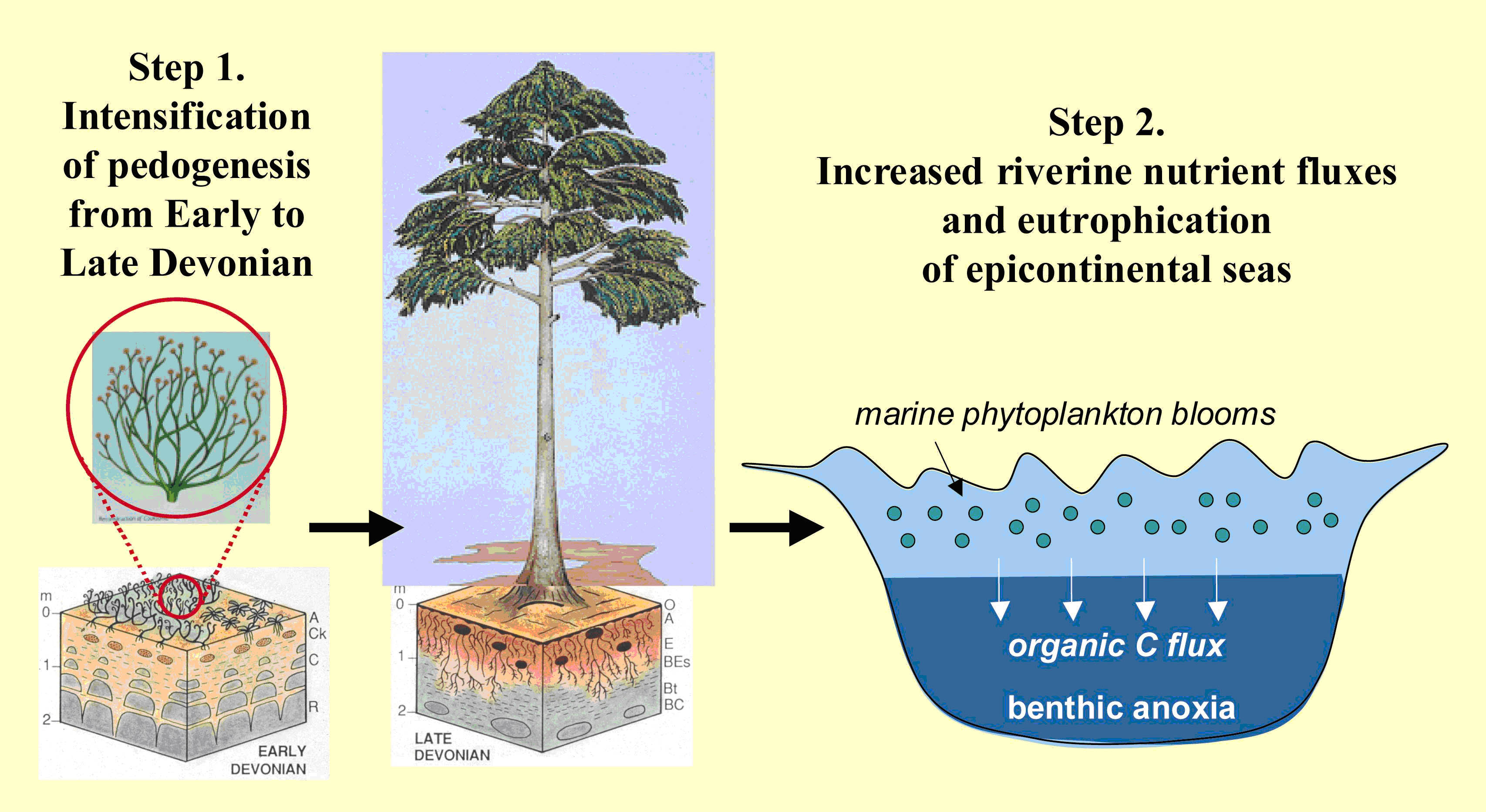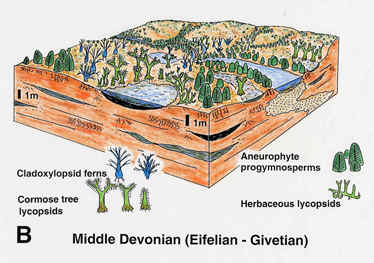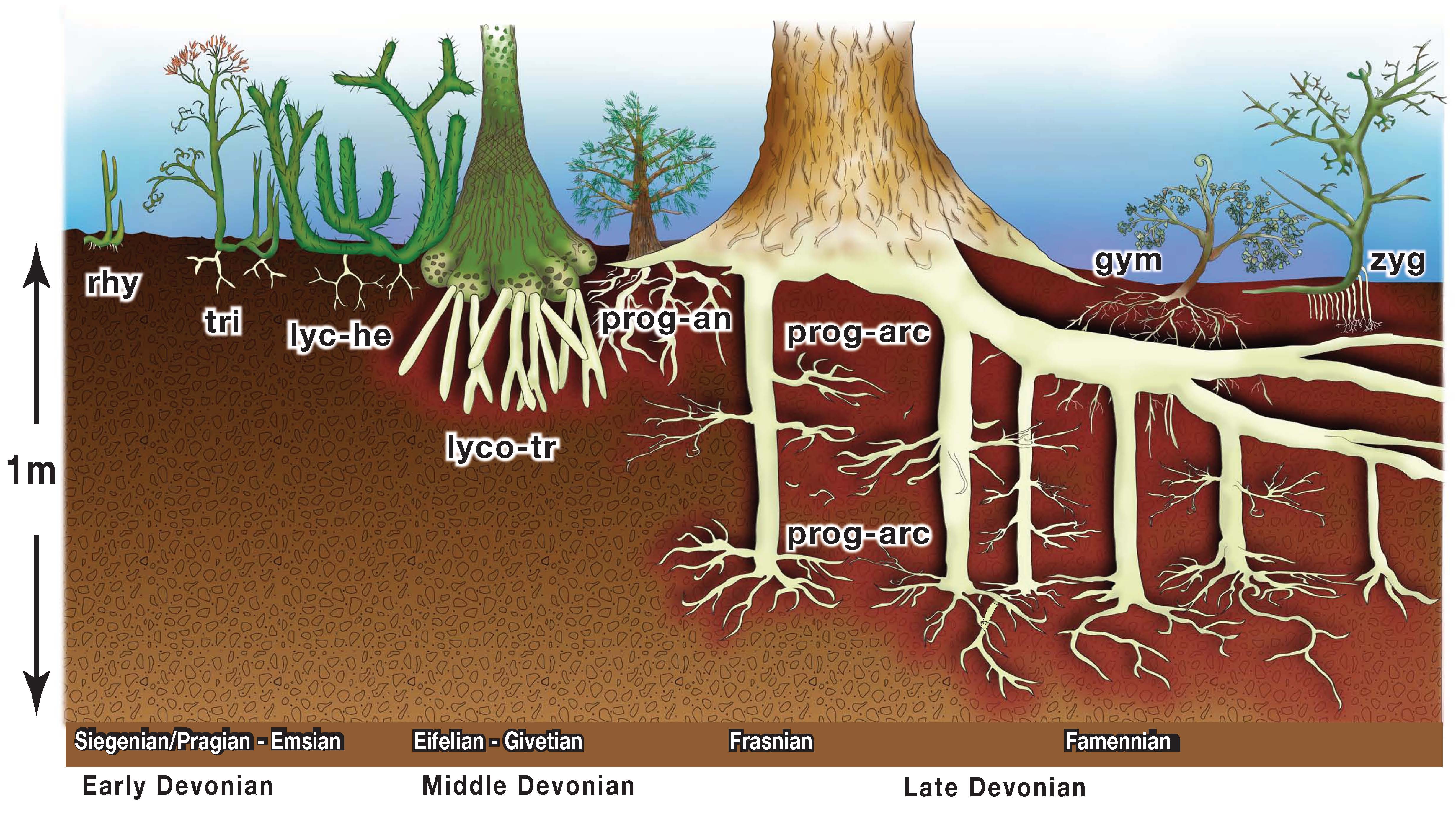



RESEARCH
Thomas J. Algeo
Professor of Geology
University of Cincinnati
The Devonian Biotic Crisis and Links to Land Plant Evolution
| The Middle to Late Devonian witnessed profound changes in the marine environment, including a major biotic crisis at the Frasnian/Famennian boundary, widespread anoxia and black shale deposition, and large anomalies in the geochemical cycles of C, P, and S. In 1993, I proposed a new theory linking these events to the evolution and spread of vascular land plants and to rapid terrestrialization of continents (Algeo, 1993; Algeo and Maynard, 1993). The key idea is that the development of arborescence (trees) and seeds during the Middle to Late Devonian allowed large land plants to rapidly spread across continental surfaces, causing a transient increase in rates of pedogenesis (soil formation) and chemical weathering. I have elaborated on this hypothesis in Algeo et al. (1995, 2001) and Algeo and Scheckler (1998, 2010). |
 |
|
 |
 |
These paleobotanical developments resulted in major changes in terrestrial ecosystems and global climate. In the Early Devonian, land plants were exclusively small (few tens of centimeters), shallowly rooted, and limited to moist lowland habitats (far left; adapted from Algeo and Scheckler, 1998). By the end of the Devonian, higher land plants had evolved leaves, complex root systems, secondary supporting tissues (leading to tree-sized plants), and desiccation- resistant reproductive propagules (seeds) that facilitated their spread into drier upland habitats (left). These changes resulted in an increase in organic carbon burial, a rise of O2 and drawdown of CO2 in the atmosphere, and global climatic cooling, setting the stage for the Late Paleozoic Ice Age. |
| One of the most important consequences of the spread of vascular land plants during the Devonian was a major increase in the depth and geographic extent of mature soil development (right; adapted from Algeo and Scheckler, 1998). Root systems developed rapidly during the Middle and early Late Devonian as progymnosperms and other arborescent plants appeared. These developments may have led to a short-term increase in chemical weathering intensity and a rapid drawdown in atmospheric CO2 during the Devonian. Increased weathering rates led in turn to an increased flux of river-borne nutrients, eutrophication of epicontinental seas, widespread development of benthic anoxia, and increased rates of extinction (i.e., at the F/F boundary). The hypothesis yields testable predictions regarding secular variation in chemical weathering rates, marine primary productivity, paleosol structure and composition, and paleoclimate changes. |  |
|
References
Algeo,
T.J., 1993, The Middle-Late Devonian increase of land plant biomass: Source of a
global biogeochemical crisis: SEPM Annual Meeting,
Algeo,
T.J., and Maynard, J.B., 1993, The Late Devonian increase in vascular plant
"rootedness": Source of coeval shifts in seawater chemistry:
Geological Society of America Annual Meeting,
Algeo, T.J., and Scheckler, S.E., 1998, Terrestrial-marine
teleconnections in the Devonian: Links between the evolution of land plants,
weathering processes, and marine anoxic events: Royal
Society of London Philosophical Transactions (B): Biological Sciences, v.
353, p. 113-130.
Algeo, T.J., and Scheckler, S.E., 2010. Land plant evolution and weathering rates changes in the Devonian. Journal of Earth Science, v. 21, Supplement 1, p. 75-78.
Algeo, T.J., Berner, R.A., Maynard, J.B., and Scheckler,
S.E., 1995, Late Devonian oceanic anoxic events and biotic crises:
"Rooted" in the evolution of vascular land plants?: GSA
Today, v. 5, p. 45, 64‑66.
Algeo, T.J., Scheckler, S.E., and Maynard, J.B., 2001,
Effects of early vascular land plants on weathering processes and global
chemical fluxes during the Middle and Late Devonian. In: Gensel, P., and
Edwards, D., eds., Plants Invade the Land:
Evolutionary and Environmental Perspectives:
Last updated 17 Sept 2012